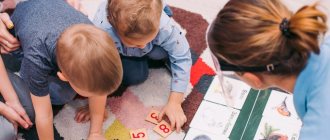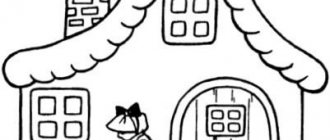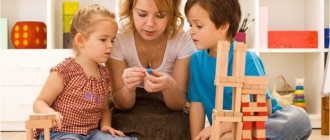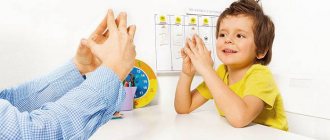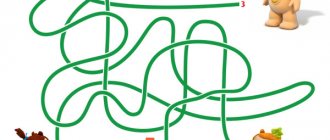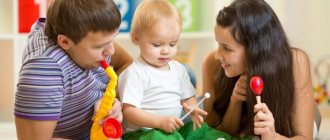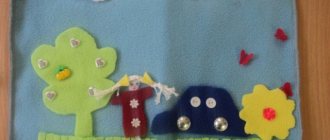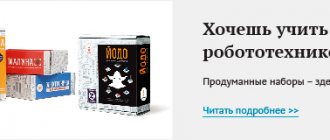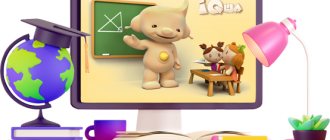Games and exercises to develop thinking in preschool children
2nd junior group (children 3 – 4 years old)
Game “In the garden, in the vegetable garden...”.
Goals: develop classification skills; help explore the order of things.
Game material and visual aids: cards with images of a vegetable garden, garden, forest; figures of vegetables, fruits, berries, mushrooms (cut out of cardboard).
Description: invite the child to correctly distribute the cut out figures, remembering what grows where: vegetables - in the garden, berries and mushrooms - in the forest, fruits - in the garden.
Game “What should we put in the refrigerator?”
Goals: develop classification skills; help explore the order of things.
Game material and visual aids: cards with images of a refrigerator, wardrobe, china cabinet, bookcase, images of objects stored in the refrigerator, wardrobe, etc.
Description: tell your child a story about how one boy decided to indulge himself: he took out all the food from the refrigerator, clothes from the closet, as well as all the dishes and books. All the things were mixed up, and he could not put them back in place, but the boy’s mother would see and be upset. “Let’s help the child and put everything in its place: food next to the refrigerator, clothes near the wardrobe, books near the bookcase, dishes in front of the cupboard.”
Game "Comparison of quantities."
Goal: to develop comparative analysis skills, speech, logical thinking.
Game material and visual aids: wide and narrow strips of paper, cubes.
Description: invite the child to build houses for the mouse and for the bunny: “Do you think we will build them houses of the same size?” Encourage the child to conclude that the mouse’s house should be smaller than the bunny’s house.
After the houses are ready, tell them that the animals asked to put paths in front of their houses for guests. But to prevent guests from getting confused, the path in front of the mouse house should be narrow, and in front of the hare house - wide. Show your child how to determine which of the tracks (paper strips) is wider by placing them on top of each other. Let the child himself distribute the paths between the houses.
Game "What is it like?"
Goal: develop comparison skills.
Description: invite your child to play questions and answers. For example: “What is as round as a ball?” (Watermelon, orange, apple, etc.); “What is as white as snow?”; "What's as sweet as sugar?" etc.
Game “The cow gives...”.
Goal: develop logical thinking through connections.
Game material and visual aids: cards with images of animals, products obtained from animals (milk, eggs, wool, etc.).
Description: Arrange the cards in random order. Invite the child, next to the image of each animal, to put an image of what this animal gives us. For example: chicken - egg, feathers (you can draw a pillow); cow - milk (cottage cheese, sour cream, kefir); goat - downy yarn (draw socks, mittens), etc.
Middle group (children 4 – 5 years old)
Game "Treasure Chest".
Goal: develop analysis skills.
Game material and visual aids: box (bag); any edible (inedible) thing that fits in a box (bag).
Description: ask your child to guess what’s inside using ten questions.
Game "Who was who?"
Goal: develop thinking.
Description: the child must name the state that preceded what the teacher calls him.
For example:
- Who was the old man? (As a boy.)
-What was the tree? (Rostkom.)
-What was Pinocchio? (With logs.)
Game "Guess by description."
Goals: develop thinking.
Description: Prepare riddle sentences in advance that children must answer.
For example:
• A beautiful insect with colorful wings, loves to fly, feeds on nectar. (Butterfly.)
• The transport is long, consists of several parts, runs on iron rails. (Train.)
• Wild animal, lives in the forest, howls at the moon. (Wolf.)
• A wild animal with red fur always deceives in fairy tales. (Fox.)
• Fruit with yellow skin. (Lemon.)
Game "Visual yes-no-ki".
Goals: teach to analyze; develop thinking.
Game material and visual aids: cards with images of objects (animals) or small toys.
Description: place toys or pictures (no more than 10) on the table, give the child a little time to look at them. Then ask: “What object did I wish for?” The child, using leading questions (Is it on the right half of the table? Below? Is it yellow? Is it heavy? Is it round?) identifies the hidden object (picture). To begin with, it is better for the teacher to act as the questioner. This way the child will understand the game script faster.
Game "Third Man".
Goal: to learn to classify objects according to the characteristics specified in the conditions.
Description: the teacher names three words, for example: “dog”, “cat”, “fish”. The child must determine: all three words refer to the designations of wildlife, but “dog” and “cat” designate animals, but “fish” does not. This means that the word fish is “superfluous”. Examples of words: birch, pine, rose; soap, shampoo, toothbrush; milk, kefir, tea.
Senior group (children 5 – 6 years old)
Game "Collect a flower".
Goal: to develop thinking, the ability to analyze and synthesize.
Game material and visual aids: cards depicting objects related to the same concept (clothing, animals, insects, etc.).
Description: each child is given a round card - the middle of the future flower (one - a dress, the second - an elephant, the third - a bee, etc.). Then the game is played in the same way as in lotto: the presenter distributes cards with images of various objects. Each participant must assemble a flower from cards, the petals of which depict objects related to the same concept (clothing, insect, etc.).
Game "Logical endings".
Goal: to develop logical thinking, imagination, ability to analyze.
Description: children are asked to complete the sentences:
• Lemon is sour, and sugar... (sweet).
• You walk with your feet, but throw... (with your hands).
• If the table is higher than the chair, then the chair... (below the table).
• If two are more than one, then one... (less than two).
• If Sasha left the house before Seryozha, then Seryozha... (left later than Sasha).
• If the river is deeper than a stream, then the stream... (smaller than a river).
• If the sister is older than the brother, then the brother... (younger than the sister).
• If the right hand is on the right, then the left hand... (on the left).
• Boys grow up to become men, and girls... (women).
Game "Ornament".
Goal: to develop logical thinking and the ability to analyze.
Game material and visual aids: 4-5 groups of geometric shapes (triangles, squares, rectangles, etc.), cut out of colored cardboard (figures of one group are divided into subgroups differing in color and size).
Description: invite the child to consider how you can create ornaments from geometric shapes on a playing field (sheet of cardboard). Then lay out the ornament (according to a model, according to your own plan, under dictation), using concepts such as “right”, “left”, “above”, “below”.
Game "Helpful - Harmful."
Goal: to develop thinking, imagination, ability to analyze.
Description: consider any object or phenomenon, noting its positive and negative sides, for example: if it rains, this is good, because plants drink water and grow better, but if it rains for too long, this is bad, because plant roots can rot from excess moisture.
Game "Everything that flies."
Goal: develop logical thinking.
Game material and visual aids: several pictures with various objects.
Description: invite the child to select the proposed pictures based on the named characteristic. For example: everything is round or everything is warm, or everything is animate that can fly, etc.
Game "What is it made of"
Goals: develop logical thinking; consolidate the ability to determine what material an object is made of.
Description: the teacher names some material, and the child must list everything that can be made from it. For example: tree. (You can use it to make paper, boards, furniture, toys, dishes, pencils.)
Preparatory group (children 6 – 7 years old)
Game “I take it with me on the road.”
Goal: develop logical thinking.
Game material and visual aids: pictures with images of single objects.
Description: Place images face down. Invite your child to go on a sea voyage. But in order for the trip to be successful, you need to thoroughly prepare for it and stock up on everything you need. Ask your child to take one picture at a time and talk about how this item can be useful. The objects in the pictures should be very different. For example, a child takes out a picture of a ball: “The ball can be played while resting, the ball can be used instead of a lifebuoy because it does not sink, etc.” You can play out various situations: on a desert island, on a train, in a village.
Game “How are they similar and how are they different?”
Goal: develop logical thinking.
Description: the presenter offers the children two objects, the children must compare them and indicate the similarities and differences. For example: plum and peach; little girl and doll; bird and plane; cat and squirrel; an orange and an orange ball of the same size; felt-tip pen and chalk.
Game "Resettlement of birds".
Goal: develop logical thinking.
Game material and visual aids: 20 cards depicting birds: domestic, migratory, wintering, songbirds, birds of prey, etc.
Description: invite the child to place the birds in nests: in one nest - migratory birds, in another - all those who have white plumage, in the third - all birds with long beaks. Which birds were left without a nest? What birds can be placed in several nests?
Game "Associations".
Goal: develop logical thinking.
Description: children are divided into two groups. One group invites the other to talk about an object, using words denoting other objects in their story. For example, talk about carrots using the words: duck, orange, cube, Snow Maiden. (It is the same color as an orange. It can be cut into cubes. Ducks love the top part of it. If you don’t eat it, you will be as pale as the Snow Maiden.) Then the groups change roles. The subject to be described and the words-characteristics are set by the presenter.
Game "Come up with a proposal."
Goals: develop logical thinking, speech activity; develop a sense of language.
Game material and visual aids: ping pong ball.
Description: the teacher sits with the children in a circle and explains the rules of the game. He says some words, and the children come up with a sentence using this word. For example: the teacher calls the word “close” and passes the ball to the child. He takes the ball and quickly answers: “I live close to the kindergarten.” Then the child says his word and passes the ball to the person sitting next to him. So, in turn, the ball passes from one player to another.
Progress of the game:
We look at all the toys one by one with the child, and then say: “these toys should be put into 2 boxes so that each box contains toys that are somewhat similar to each other.” In case of difficulty, the teacher puts the first pair of Christmas tree toys next to each other and asks the child to compare: “how do these Christmas trees differ from each other?”
. If the child cannot find the main difference, the teacher draws the child’s attention to the material from which these toys are made. Then the child acts independently. At the end of the game, it is necessary to generalize the principle of grouping: “in one box - all wooden toys, and in the other - all plastic ones.”
"It flies - it doesn't fly"
Progress of the game:
Invite your child to quickly name objects that fly when he says the word “flies”
, and then name objects that do not fly when he says the word
“does not fly
. The game can be played while walking.
"Edible - not edible"
The game is played in the same way as the previous one. Say the words "edible"
,
"not edible"
.
"Be careful"
Progress of the game: Tell your child: “I will name four words, one word does not fit here. You must listen carefully and name the extra word.” For example: matryoshka, tumbler, cup, doll; table, sofa, flower, chair, etc. After each highlighted “extra”
words, ask the child to explain why this word does not fit into this group of words.
2. Games to develop the ability to perform systematization.
"Housewarming party at the nesting dolls"
Goal: to teach children to compare objects, to see their different properties in objects, to arrange objects in a certain order, highlighting an essential feature.
Progress of the game: you say: “The nesting dolls have settled in a new house. Each got their own apartment. The smallest one is on the first floor, a little larger on the second, even larger on the third, even larger on the fourth. And on the fifth and last floor is the largest one. They were happy about their apartments and went for a walk in the park. They arrived in the evening and forgot who lived where. Help the nesting dolls find their apartments. Tell them where their apartments are.
Game “Guess: floats or sinks?”
